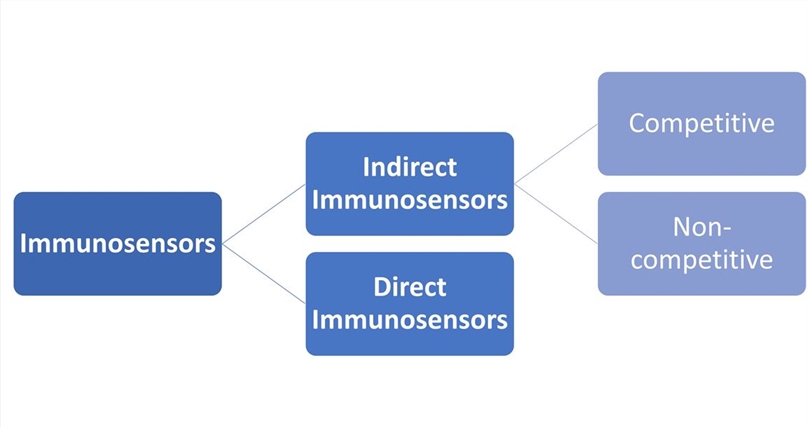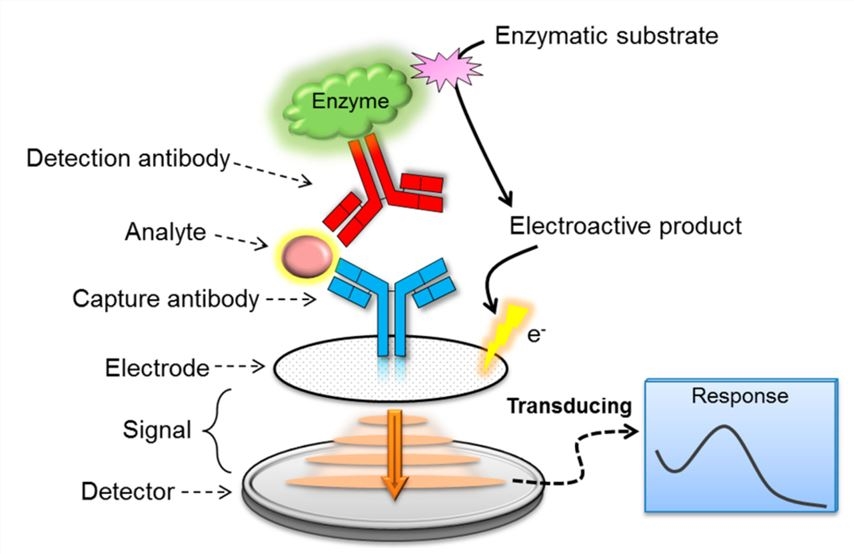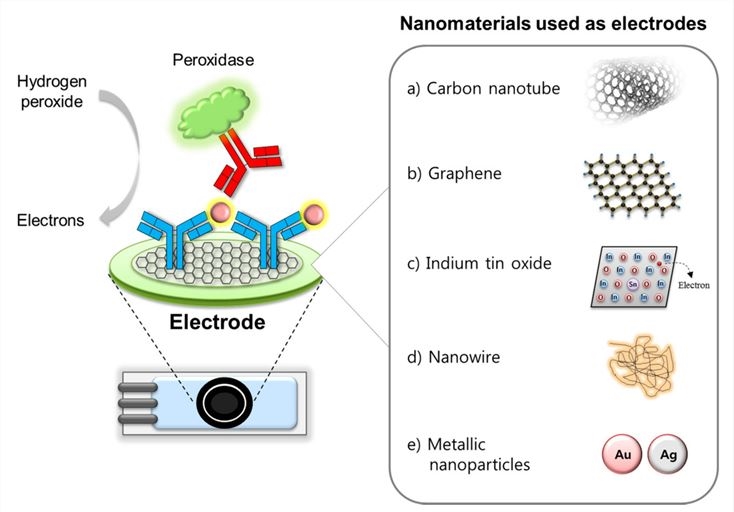An immunosensor is a kind of affinity biosensor based on the interaction between the antigen and specific antibody immobilized on a transducer surface. Electrochemical immunosensors rely on the measurements of an electrical signal recorded by an electrochemical transducer and can be classed as amperometric, conductometric, potentiometric, or impedimetric depending on the signal type. Recent years, electrochemical immunosensors have been more perfected due to their simplicity, ability to be portable, and for in situ or automated detection.
Detection Methods
- Direct Immunosensors
- Indirect Immunosensors
- Competitive immunosensors are useful for small antigens with one epitope in which the sample analyte and labeled analyte compete with each other to access the limited number of antibody-binding sites. Competitive immunoassays can be carried out in two different ways, homogenous or heterogeneous approach. In the homogenous assay, the amount of labeled unbound antigen is measured with no need for separation steps, but in the heterogeneous assay, the labeled bound antigen is measured after removing the labeled unbound antigen by using a washing step.
- Non-competitive immunosensors, also known as sandwich Immunosensor, are applied for large antigens with epitopes of more than one. In this assay, excess amounts of secondary and primary antibodies are used and the antigen is sandwiched between two antibodies.
Direct immunosensors, also known as label free immunosensors, are capable of detecting the chemical or physical changes arising directly from the antigen-antibody complex formation without label. However, this kind of immunosensors suffer from a significant effect of non-specific adsorption on their response. A proper blocking agent is necessary.

In the indirect immunosensors or labeled immunosensors, labels can be attached to an antibody or antigen to achieve an electron-transfer and assuming that the number of labels detected during measurement correspond to the number of target analytes. Labeled immunosensors can be further divided into two formats: competitive and non-competitive format.
 Fig.1 Diagram illustrating the structure and operational principles of an electrochemical biosensor.1
Fig.1 Diagram illustrating the structure and operational principles of an electrochemical biosensor.1
Immobilization Methods
- Physical Adsorption
- Trapping Methods
- Covalent Binding
- Affinity Immobilization Techniques
Physical adsorption is the simplest method for binding an antibody to the electrode surface based on non-covalent interactions between the bio element and the surface of the sensing device.
This method is based on the encapsulation of bioelements in polymer matrices such as molecularly imprinted polymers (MIP) and sol-gel.
The covalent binding strategy is most frequently used in the immobilization of bioelements based on covalent interactions between the surface of the modified electrode and the functional groups of antibodies or aptamers. Functional groups of antibodies for covalent binding include amine, carboxyl, carbohydrate, and thiol moieties.
Affinity immobilization techniques are favorable strategies for obtaining high capture efficiency and oriented immobilization of the biorecognition elements to achieve a high performance immunosensor. Bio-affinity immobilization techniques are based on material binding peptides, protein A/G, biotin-streptavidin interaction, Fc-binding peptides, aptamers, lectin-sugar, His-Tag systems, nucleotide binding site, and DNA-directed immobilization.
Functional Nanomaterials as Electrodes
Many attempts have been made to improve the electrochemical properties of conventional and screen-printed carbon electrodes via employing various novel nanomaterials. Nanomaterials have huge surface areas, which can also support increased loading capacity and the mass transport of reaction molecules, resulting in a synergic contribution to signal amplification. Some promising nanomaterials used as electrodes are shown in Figure 2.
 Fig.2 Enhanced analytical performance of electrochemical immunosensors utilizing nanomaterials.1
Fig.2 Enhanced analytical performance of electrochemical immunosensors utilizing nanomaterials.1
Application
Immunosensors can be designed for biomarkers detection. Since multiple detection of biomarkers provides more accurate information, the detection of clinical biomarkers by using the same immunosensor hold enormous potential for early detection. Electrochemical methods give a ground for choice by researchers since they give a rapid response and a specific electrochemical response towards analyte. Electrochemical immunosensors in clinical analyses have frequently found a place due to their rapid response in terms of exist or not exist. Creative Biolabs believes that as the technology is developing very quickly, there will be picomolar level sensors as early grade detection of illness.
Reference
- Cho, Il-Hoon, et al. "Current technologies of electrochemical immunosensors: Perspective on signal amplification." Sensors 18.1 (2018): 207. Distributed under Open Access license CC BY 4.0, without modification.
For Research Use Only.

